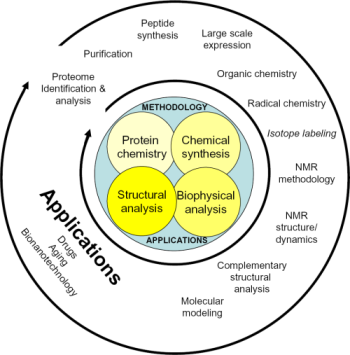If you have any questions about inSPIN, please contact inano@inano.au.dk.
inSPIN was established at Interdisciplinary Nanoscience Center (iNANO) in 2005 by a donation from the Danish National Research Foundation. The research center combined the expertise from research groups specializing in solid- and liquid-state NMR spectroscopy, organic chemistry, protein chemistry, and biophysics. In 2010, the grant from the Danish National Research Foundation was extended by 5 years, with new the new focus to use the structural and functional insight towards biological intervention.
The center was hosted by iNANO and directed by Prof. Niels Chr. Nielsen (iNANO and Department of Chemistry).
While a good understanding of soluble proteins is available, our focus is the more challenging group of "insoluble" proteins for which only little structural information is available.
In inSPIN, the mission was structural characterization of biological macromolecules to generate knowledge that can be used systematically to design ways for biological intervention. The center generated and exploited results from structural and functional analysis to rationally design synthetic antimicrobial peptides, small molecule inhibitors for fibril formation, new contrast agents for early-stage detection of amyloid diseases, and a molecular basis for understanding extracellular matrix degradation, to name some specific targets.
The center developed and applied new methods for analysis of proteins in insoluble biological structures, including membrane proteins, fibrillating proteins, and extracellular matrix proteins. These proteins constitute about half the proteome of any cell and are involved in essentially biological functions.
The research activities in the inSPIN research centre was highly interdisciplinary, and involved the combination of Protein Chemistry, Chemical Synthesis, Biophysical Analysis, Structural analysis, and Molecular Dynamics simulations as illustrated in the diagram below:

In combination these research competences (and competences established through external collaborators) formed an excellent platform for studying proteins in insoluble biological structures. The research was focusing on development of the required methodologies as well as applications in the areas of membrane proteins, fibrils, and extracellular matrix proteins.